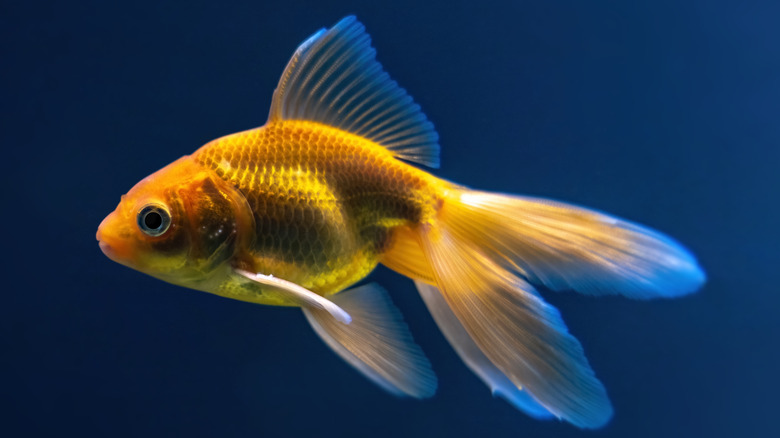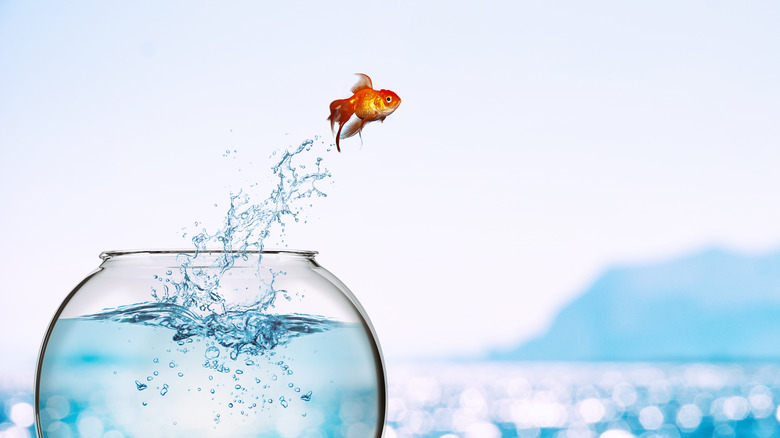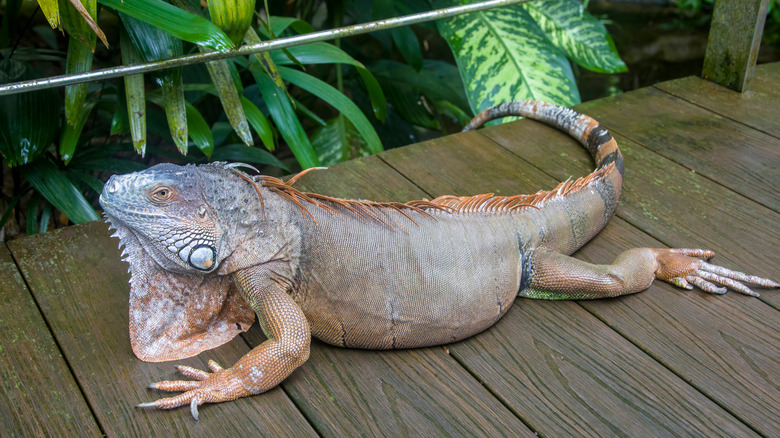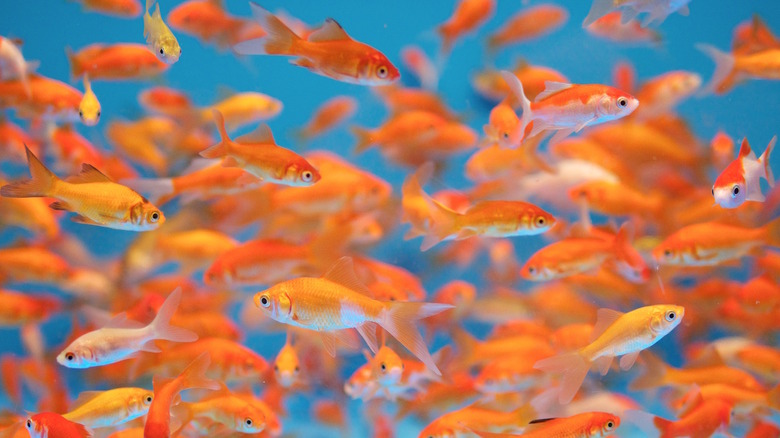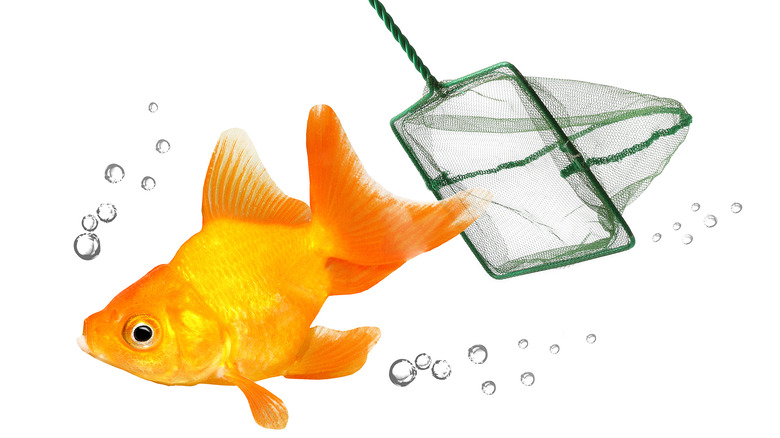Why Goldfish Are So Dangerous In The Wild
Goldfish are the most common freshwater fish kept in aquariums. They're colorful, friendly, and sturdy and make for perfect frill-free pets. Although originally native to Asia, they are now found all around the world. Goldfish actually belong to the carp family, which can range in size from half an inch to a massive 10 feet in the case of the giant barb. While the goldfish you're used to is likely just a few centimeters in size, goldfish can grow very big given the right environment. In captivity, however, they are restricted by the size of their aquariums, which often keeps them small (per BBC).
Goldfish can have impressively long lifespans under the right conditions — as long as 30 years for a healthy, well-fed, properly cared for goldfish. For example, in 2014 a goldfish made headlines in Australia for going under the knife to remove a tumor. The 10-year-old beloved goldfish made it through the surgery fine, with the vet explaining he could easily live a couple more decades after that (via BBC).
Then there was Tish. According to The Guinness World Records, Tish lived a long happy goldfish life before passing away at the age of 43. The average captive goldfish only lives four to five years, though, mostly because of poor care and breeding practices, as reported by Aquarium Source.
So who thought releasing goldfish into the wild was a good idea?
People have been releasing animals into the wild for a long time. Surprisingly, many do it for what seems like a good reason: They want the animals to live "freely" in a more natural habitat. The truth, however, is that animals kept as pets have been bred to be pets. Most aren't equipped to survive on their own — many will starve, others will be hit by cars or die from weather exposure (per The Spruce Pets).
In some cases, pets aren't even native to the U.S. — as it's the case with many reptiles and birds — and when released, they will take over the environment and even pose a risk to people. For example, you can own a pet alligator in several states, which, of course, is a terrible idea and cannot possibly end well. A good example, as described in National Geographic, a thief stole two American alligators from a pet store in Kansas and released them into a local creek in 2020. If not captured, they could have injured pets or people as they got older and bigger and needed bigger prey.
Most goldfish released into the wild get their freedom for more practical reasons. Sometimes their owners are moving and cannot take an aquarium tank with them. Or maybe the goldfish is just getting too big for the tank and owners think he'll be better off in a river. This is never the case.
Pets released into the wild often turn into something out of a horror movie
Ethics aside (let's agree that it's cruel to release domesticated animals into the wild if we know they won't make it out there), releasing a nonnative species can cause serious damage to the ecosystem. If they do survive, they can create serious problems for native species, affecting the food chain, spreading disease, or competing for limited resources (via The Spruce Pets).
In fact, released pets have created all kinds of chaos. For example, Burmese pythons are causing major issues in Florida's Everglades National Park, including feeding on local wildlife (which has led to declining populations of opossums and bobcats). According to One Green Planet, these snakes were likely once pets that become too big to handle, so they were released into the wild. Released iguanas are damaging the local vegetation in Florida too, and Veiled Chameleons released in Hawaii are having a feast with the local insects and birds, causing serious damage (per Hawaii Invasive Species Council).
It's not just bigger animals that can become pests when released into the wild. Giant African snails are not native to the U.S. and illegally kept as pets, but over the past decade, many have been abandoned in the wild. Not only can they destroy crops and vegetation, but they can also carry a parasite that causes meningitis, according to The Spruce Pets.
When goldfish are released, things don't go much better
Sure, goldfish look pretty adorable when they're at home in an aquarium, but they turn into an invasive, monster-size species in the wild. In 2013, researchers found a 4.2-pound, 1.5-foot long goldfish in Lake Tahoe. The massive fish wasn't alone either — there were enough smaller goldfish around that it was likely the fish were reproducing, according to Live Science. In Lake Tahoe, this resulted in two major issues: The massive goldfish were feeding on native species and excreting nutrients that increased the production of algal blooms, which in turn affected water clarity and cleanliness.
According to BBC, releasing goldfish is illegal in much of the U.S. because of this. Yet, that doesn't mean people aren't still doing it. In 2020, a small county in Minnesota removed 50,000 goldfish from a creek. Although it's hard to say how many were originally released and how fast they reproduced, the very large number present is a good indication of how invasive the species can be.
The problem is not just exclusive to the U.S., either. Europe is experiencing a similar issue in ponds and lakes. In 2010, a British teenager out fishing caught a 5-pound, 16-inch fish in a local lake in the U.K. (per BBC).
Goldfish do very well on their own
One of the issues with releasing goldfish into the wild is that they are a very resilient species. While that's nice for them, it also means they can survive in all kinds of environments, including rivers, lakes, small ponds, and even ditches (via International Business Times). In difficult environments where few other species can survive, goldfish could easily take over and damage (or even completely destroy) native populations.
According to USA Today, goldfish can even survive under ice and in low-oxygen environments (such as muddy waters) where other species would struggle. Even worse, once they get bigger, they will also disturb sediment and uproot plants, worsening water quality and potentially killing a bunch of their fish neighbors.
Goldfish aren't picky eaters either — they're omnivorous and will eat whatever looks appetizing enough. That includes fish eggs and, well, any of the fish neighbors who happened to survive the murky water, as reported by Metro. If their environment becomes less than ideal — thanks in part to the mess they created themselves — they'll move on somewhere else. When researchers tracked their movements in rivers and streams, they found that one of them had swum an outstanding 143 miles in one year.
So the goldfish are out, what now?
We might be fighting a losing battle here. According to The New York Times, goldfish can produce up to 40,000 eggs a year, and as they interbreed with other fish species, they'll just get bigger and bigger. Add to that they have no natural predators, and you have a recipe for a giant overpopulation of goldfish over just a few generations.
Removing them from lakes and streams isn't that easy, either. Any method used to try to catch them can potentially also hurt native fish species, so researchers are trying something else. In Minneapolis, scientists are using electroshock in lakes that have been heavily infested by goldfish. Once electricity temporarily stuns the fish, they are caught using nets, tagged, and released again. According to CBS Minnesota, this will allow researchers to "follow" the fish and see where they live, eat, and reproduce. The long-term goal is to find a way to manage their population rather than kill them — essentially, find a way to coexist with them while avoiding further damage to the local environment.
The moral of the story? Don't release your goldfish into waterways, no matter how much you think they would like that. Buy a bigger tank or rehome your fish instead.
